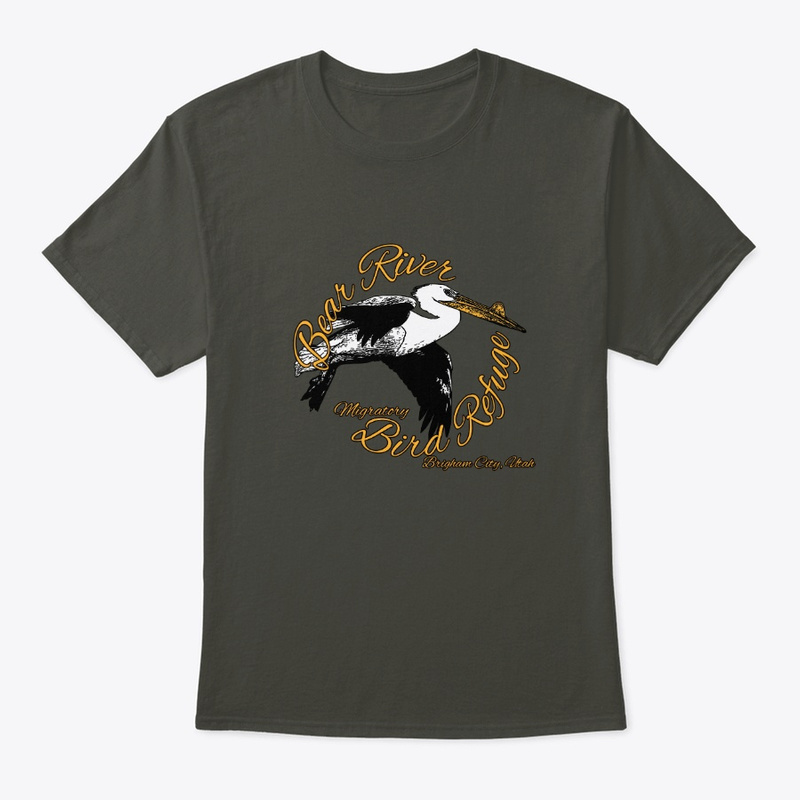As I sit and write this blog post, the tv weatherman just mentioned another record broken in Utah.
I really do hate to be the bearer of bad news but if you haven’t already heard, July was once again the hottest month on record here in the beehive state, breaking the previous mark set, well, last year at this same time.
Yikes!!! That makes two consecutive years with the hottest month ever recorded in Utah.
Besides my summer grass allergies, I think I’ve found another valid reason to somehow, someway start liking winter.
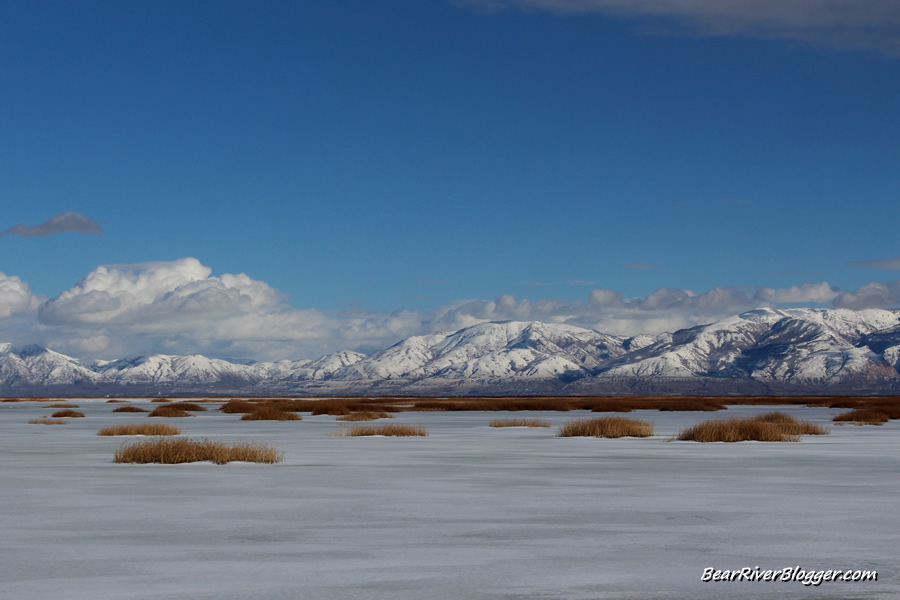
It’s not that I hate winter, I just don’t like parts of it, mainly the cold, the snow, the wind, the endless inversions, and, of course, the icy roads.
Other than that, I think I could really get on board with the winter season after a few minor changes are made to sweeten the pot.
All kidding aside, winter does have one thing no other season can offer, a spectacular backdrop for nature photography and bird watching, especially right after a snowfall has just ended.
That is contingent upon, of course, one’s willingness to sometimes brave some extremely cold temperatures and icy roads to get out and find these quiet, serene, and almost spiritual moments in nature, as it were.
Personally, I think winter is one of the best times of the year to not only photograph but also to just get out and enjoy the Bear River Migratory Bird Refuge auto tour route, a 12-mile self-guided drive through a wetland habitat that attracts hundreds of species of birds each year.
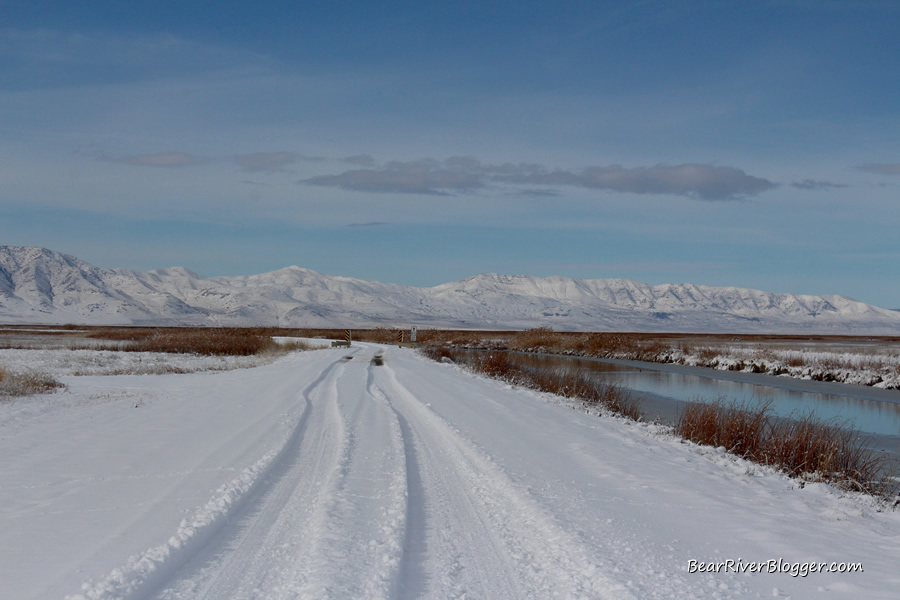
I know it might sound strange knowing my general lack of love for the winter season but, in all honesty, I actually do look forward to visiting the Bear River Migratory Bird Refuge numerous times each and every year during what I refer to as the dead of winter.
For some sights, such as the bald eagle or rough-legged hawk, winter is the only time to view these particular species of migratory birds on the refuge as they migrate from parts of far northern Canada and Alaska to spend the coldest time of year on the Bear River Migratory Bird Refuge and surrounding area in search of food.
And one of my favorite birds to photograph, the great blue heron, offer very unique and quite mesmerizing scenes for both photography and just good old-fashioned bird watching during winter as they search for and stand over small pockets of open water hoping for an unsuspecting meal to swim by, oftentimes for hours on end.
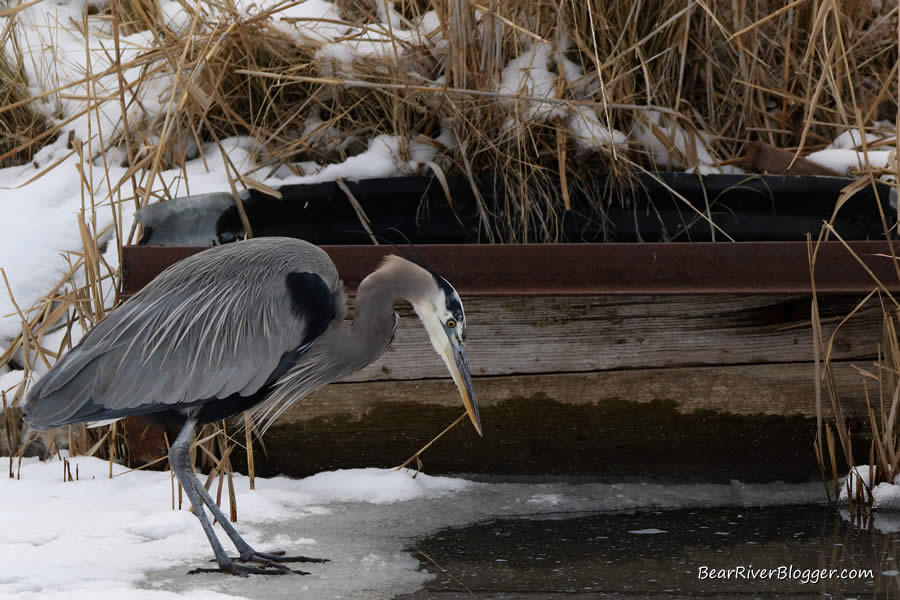
I’m convinced these stealthy and extremely patient birds could give even the most dedicated of ice-fishermen a run for their money.
There are, in fact, endless examples I could give on the matter so let me show you a few images from past trips to the Bear River Migratory Bird Refuge that will help back up my claim that winter on the refuge can be quite spectacular and, for me at least, well worth a few visits or more, even during the harshest, coldest part of the year.
Keep in mind though, as with any time of year, not every trip I take around the refuge during winter ends up being one of those mesmerizing, almost magical moments, that’s just how nature is.
Sometimes it is nothing short of breathtaking and other times, well, it’s just another ordinary day.
But when I do indeed catch the Bear River Migratory Bird Refuge on the right winter’s morning, it can be quite spectacular, to say the least.
And as always when exploring nature, I suggest contacting the Bear River Migratory Bird Refuge to get current conditions or any unexpected closures due to extreme weather conditions or any other factors before heading out.
Animal Tracks In The Snow
One part of this wintery offering I love to seek out and rather enjoy, something I think most people unfortunately overlook, is the animal tracks left behind in the snow and the stories that they could tell.
It’s not unheard of for me to venture out on the Bear River Migratory Bird Refuge auto tour route for nothing else than to search for and photograph animal tracks after a fresh, light snowfall.
When I come across such a setting, I almost always stop and try to deduce what just happened and who were the key players involved.
Sometimes it is quite obvious and other times, well, I’m left scratching my head wondering what it was that I missed.
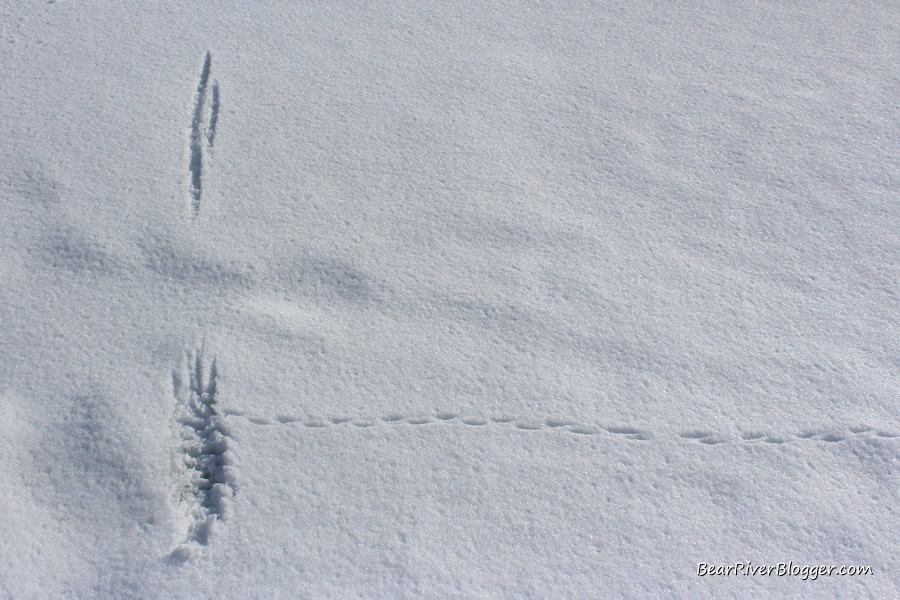
One morning while traversing the Bear River Migratory Bird Refuge auto tour route just after a fresh snowfall, I came across a most interesting scene that quickly caught my eye.
It was the well-defined and most untimely, for one of the participants that is, tracks left behind after an American kestrel and a mouse crossed paths earlier that morning.
The tracks left in the snow depict a survival story that plays out in nature each and every day and one that was perfectly recorded on this fresh winter’s canvas.
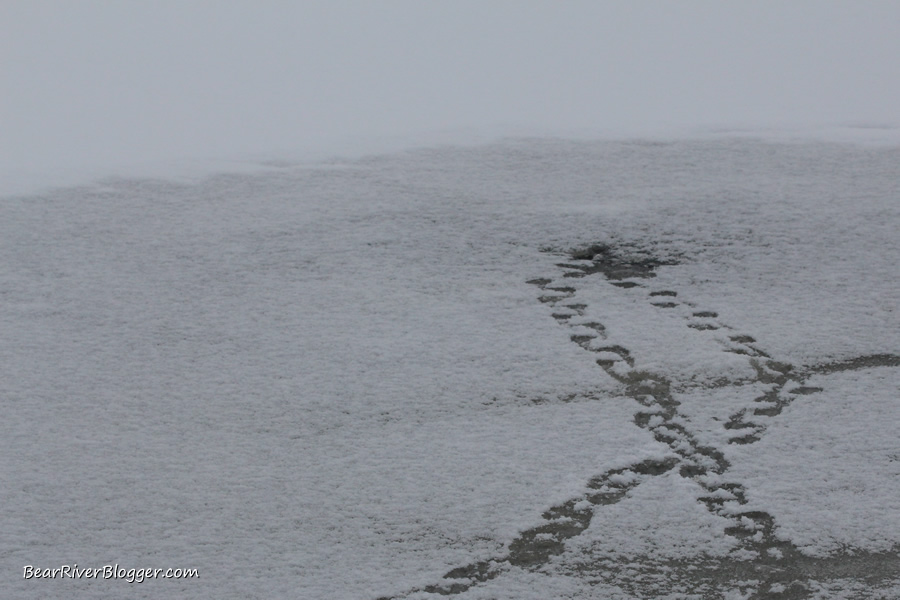
On a particularly cold afternoon, I came across an older set of tracks where a great blue heron previously landed and walked out to investigate a small hole in the ice and, for reasons unknown, left the hole and walked back to where it landed.
Great blue herons live on the Bear River Migratory Bird Refuge year-round and can be found standing near a small ice hole for hours hoping for a fish to swim by just under the water’s surface.
It’s almost as if they leave their large tracks in the snow for us as a reminder of how hard it is for a fish-eating bird to survive the cold winter season where temperatures can be below freezing for several months or more.
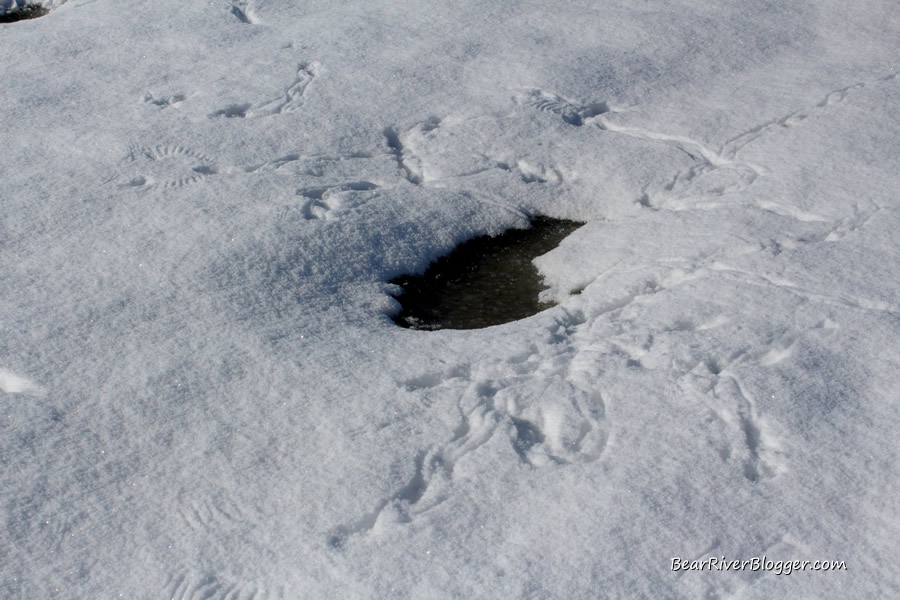
This particular set of animal tracks in the snow has a lot going on, and if you look closely you might deduce it quite possibly has an American kestrel chasing both small birds and a mouse by the shape of the tracks.
In the upper left corner, you can see what I am thinking is an American kestrel imprinted in the snow after diving for a small bird, at least from what I can deduce, that is, from the size and structure of the perfectly shaped snow angel and tracks left behind.
And in the opposing upper right corner, it looks like that same kestrel crossed paths and scuffled for a moment with what I am assuming is a mouse or vole of some kind.
When I arrived on the scene numerous small birds were scattered around the area, quite possibly drawn to the small bare patch that from a distance must have looked like open water to a thirsty bird.
So many things are happening in nature and it’s very interesting to go out during winter and get a peak at what we miss the rest of the year, brief moments of everyday life in the natural world that only get recorded for a short period of time on a fresh, wintery white canvas.
It is quite enjoyable to try and deduce what previously played out where there were no witnesses, no evidence except what was written on a fresh blanket of snow.
Great Blue Herons
If you were to ask me what my all-time favorite winter bird was, I could very easily make a case for the great blue heron.
The great blue heron is not what we would call a traditional winter bird, per se, because here in Utah great blue herons don’t actually migrate but rather stay year-round, only moving from locale to locale in search of open water or an upland place to hunt rodents.
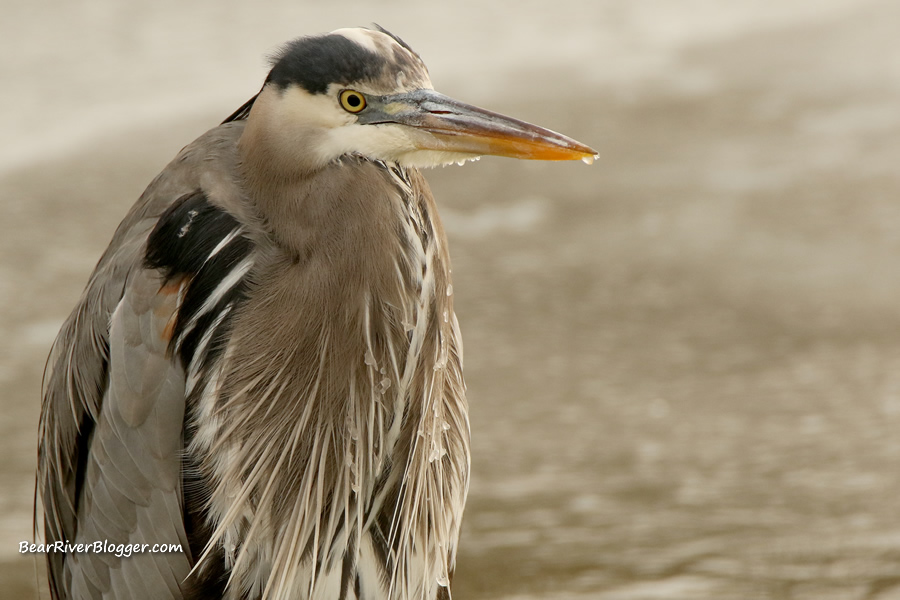
There is something just so sobering about seeing a fish-eating bird all covered in ice.
It’s a scene often found in late December and January on the Bear River Migratory Bird Refuge where temperatures can stay well below freezing for weeks on end.
I have wondered for years how and why great blue herons don’t migrate south for the winter but stay put here in northern Utah, even when the temperatures can be quite harsh at times.
Truth is, great blue herons have found ways to adapt to cold, even freezing climates, by, in part, hunting for rodents in fields when there is no open water to be found.
A few years ago in January while photographing bald eagles at Farmington Bay, I watched a great blue heron land just up ahead of me on the gravel road and stalk the tall grasses until it found and caught a large vole.
But it wasn’t until a few Christmas Eves ago when I spent most of the day on the Bear River Migratory Bird Refuge where I found out how many of the great blue herons survive the sometimes brutal Utah winters.
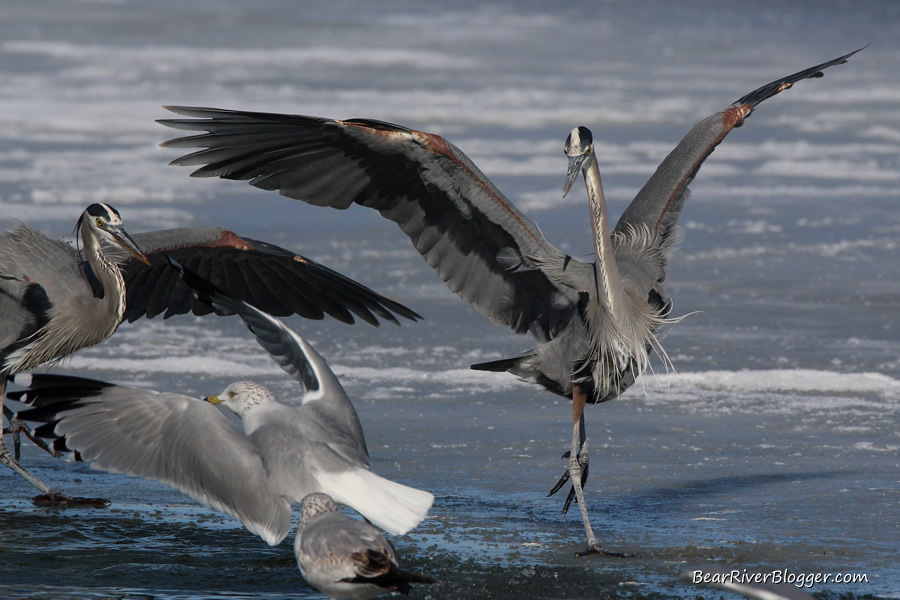
In short, what I witnessed then and countless times afterward is great blue herons will stand on the edge of the ice waiting for a diver duck, typically a golden-eye, for example, to dive under the water and come up with a fish in its beak.
The great blue heron will then abruptly rush the duck, hoping it will then drop the fish and become a quick meal for the large heron.
This is a scene that plays out on the south end of the auto tour route almost every winter when all but a small pocket of water freezes over and gulls, diver ducks, and great blue herons congregate and fight over what food the ducks provide by diving down in the icy water after the small fish.
Bald Eagles
We all love the iconic bald eagle and why not, they are some of the most impressive and beautiful birds in nature.
Each winter, dozens or more bald eagles come to the Bear River Migratory Bird Refuge to hunt for ducks, other birds, and even fish whenever possible.
On the way down to the auto tour route, about a half mile before the gate, an old wooden post of some kind can be found on the north side of Forest Street.
It casually leans to one side, but oftentimes during winter it is adorned with a bald eagle that sits contently atop the large wooden post.
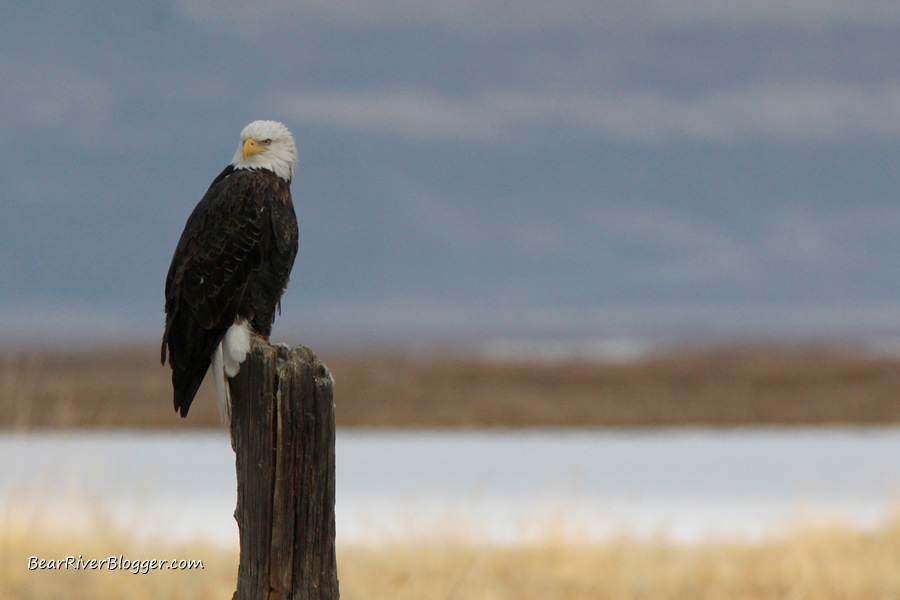
Bald eagles can be found all over the Bear River Migratory Bird Refuge, up and down Forest Street and along the 12-mile auto loop, but this old fence post seems to quite consistently have a bald eagle sitting on it when I visit the refuge during winter.
The southern portion of the refuge auto tour route will also consistently have multiple bald eagles but many times the large birds of prey are sitting pretty far out on the ice.
When it comes to winter encounters with bald eagles, however, one moment will forever stick out in my mind and will serve as a reminder that nature has no favorites and neither should we as all actors on this great stage are important and have a purpose.
It was quite a somber moment but I will do my best to treat it with the respect both parties involved deserve.
A few years ago, I was sitting at the Bear River Migratory Bird Refuge boat launch parking lot on the Bear River itself, just a hop, skip, and a jump from the start of the auto tour route.
I had my camera held on a great blue heron when all commotion broke out.
An immature bald eagle was circling above and without any warning, it abruptly dove down to the icy water and picked out an unsuspecting pied-billed grebe from the water’s surface.
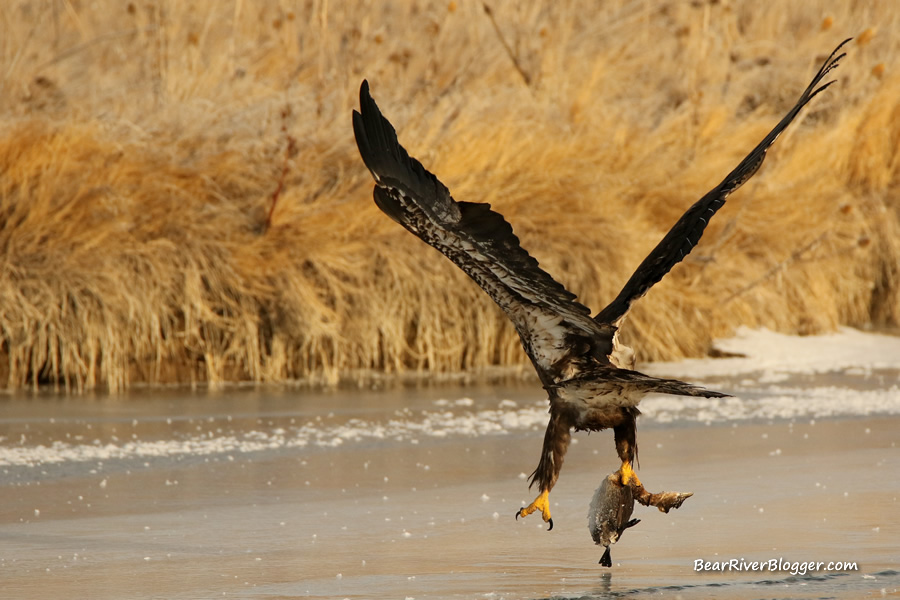
It was both exciting and sad for me at the same time.
I felt bad for the grebe but I also felt the eagle needed to eat during this most difficult of times when winter was in full force.
Despite the commotion and brevity of the situation, I was able to capture a couple of images of the scene that played out before me.
It reminded me that nature is real and it can be hard at times to watch.
The scenario compelled me to write a blog piece about who should we root for in nature regarding this very scenario that I was able to view as well as photograph and it honestly made me really think and truly appreciate nature as a whole.
Tundra Swans
One of the more well-known and easier-to-find winter scenes on the Bear River Migratory Bird Refuge is the migrating tundra swans.

Only there for a few short weeks or so, thousands of migrating tundra swans stop over on the Bear River Migratory Bird Refuge, usually starting in February most years, for a bit of food and rest.
The swans make for some great late-winter bird watching and photography for sure.
It has become such a grand spectacle, that the Bear River Migratory Bird Refuge usually hosts an annual Swan Day event, typically on the second Saturday of March when it’s been able to be held.
(Migrating Tundra Swans On The Bear River Migratory Bird Refuge.
Don’t forget to subscribe to our Bear River Blogger YouTube channel for short nature clips such as this as well as periodic updates about the Bear River Migratory Bird Refuge.)
Scenery
Maybe it’s just me but I do find beauty in a frozen wetland.
Sometimes it can produce some interesting winter scenes, such as a flock of tundra swans being framed by a snow-covered Promontory Mountain range and subsequent reflection in the perfectly still water below.

Simply put, certain scenes in nature just speak to me, usually moments that other people might miss or not pay any attention to.
One such moment was seeing a bent-over reed on a cold winter’s day that, for some reason unknown to me, caught my eye and compelled me to take a quick picture.
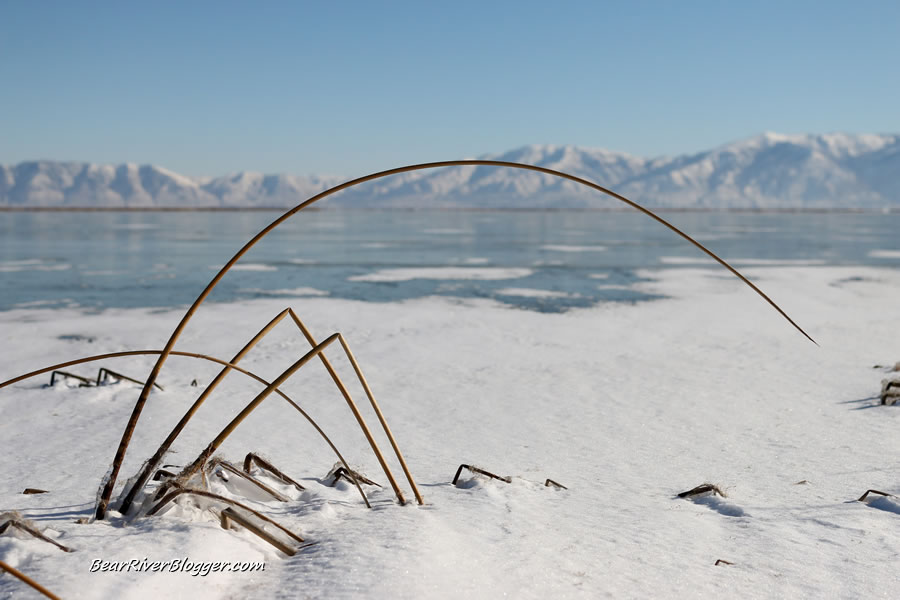
From what I remember years ago when this image was taken, the hanging reed and the frozen wetland along the refuge auto tour route struck a chord with me, one of sadness from all the harsh conditions birds and other creatures have to endure during winter.
I don’t know for sure but even when I look at this image now I still feel a bit of the somberness for nature during winter that I felt when this particular scene presented itself to me several years ago.
Owls
Winter is quite possibly the best time of the year to see owls on the Bear River Migratory Bird Refuge, especially for the barn owl.
Seldom seen during the day, barn owls are typically nocturnal, meaning they hunt at night so viewing them during the daytime for most of the year is quite rare.

But during a particularly strong winter, it’s not uncommon for barn owls to be out during the daytime hunting for mice and voles.
It is a very hard time for barn owls when you see them hunting during the daytime hours so never, ever chase them for a photograph as it is a very stressful time just to find enough food to keep them going.
Another owl that can be found on the Bear River Migratory Bird Refuge during winter, well, year-round actually, is the short-eared owl.
There is something so captivating about seeing a short-eared owl in the wild, maybe even more so during the harshness of winter.
A few years ago, I was driving home from a trip around the Bear River Migratory Bird Refuge auto tour route and came across this short-eared owl perched very contently on a large fence post.
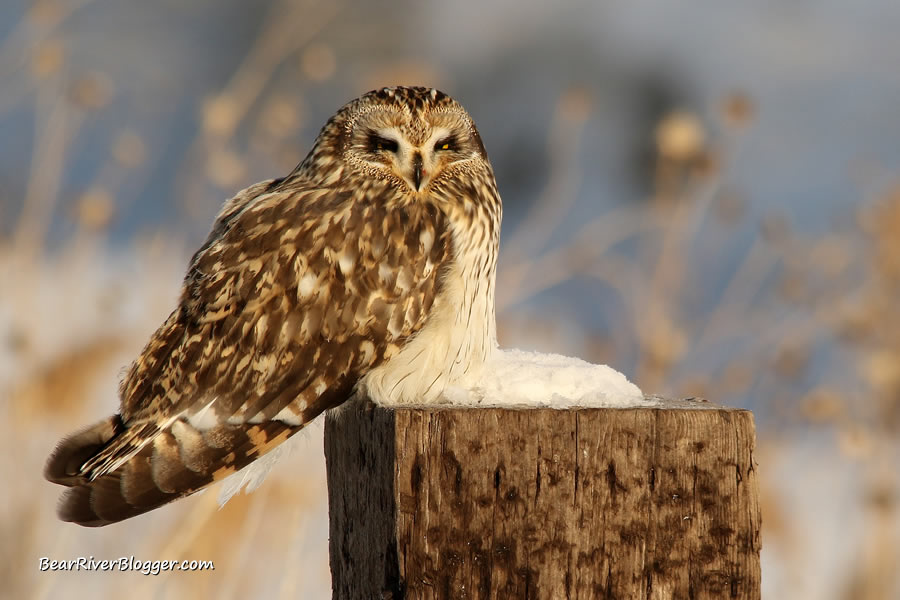
I must admit, with how cold it was on that particular day, well below freezing mind you, the owl was in no mood to be bothered so I kept a good distance and used my 600 mm lens to take a few images from inside the vehicle so as to not disturb the owl.
Short-eared owls can be found year-round on the Bear River Migratory Bird Refuge during dusk and dawn, especially on Forest Street, but it’s not uncommon at all to see them during the day during a cold winter.
And much like the barn owl, give the short-eared owl, well, all daytime owl sightings during winter that is, their due space as this time of year they are very stressed as it is.
Enjoy them and photograph them from a distance but let them be.
Subscribe
If you are a fan of nature, we offer you to head on over to our subscribe page and sign up for email notifications for future blog posts.
We blog about nature, both on and off of the famed Bear River Migratory Bird Refuge, and enjoy bringing you some of what we are able to find and capture with our camera in hopes that you will have as much of a fondness for nature as we do.
Bird Apparel
If you’re in the market for a bird-related gift for yourself or someone else, visit our online store, and don’t forget to use coupon code save20 for 20% off our latest offering, a Bear River Migratory Bird Refuge t-shirt that is available in a variety of styles and colors.
